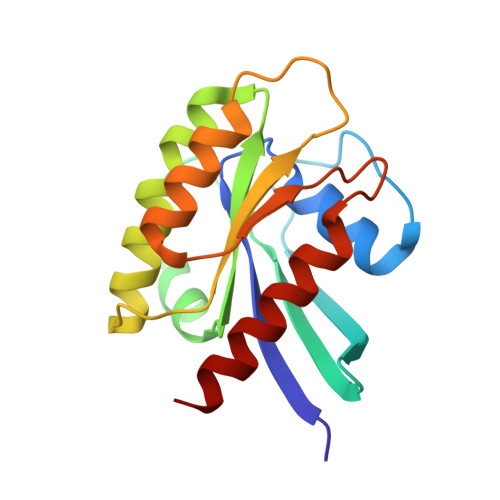Structure-Based Design and Pharmacokinetic Optimization of Covalent Allosteric Inhibitors of the Mutant GTPase KRASG12C.
Kettle, J.G., Bagal, S.K., Bickerton, S., Bodnarchuk, M.S., Breed, J., Carbajo, R.J., Cassar, D.J., Chakraborty, A., Cosulich, S., Cumming, I., Davies, M., Eatherton, A., Evans, L., Feron, L., Fillery, S., Gleave, E.S., Goldberg, F.W., Harlfinger, S., Hanson, L., Howard, M., Howells, R., Jackson, A., Kemmitt, P., Kingston, J.K., Lamont, S., Lewis, H.J., Li, S., Liu, L., Ogg, D., Phillips, C., Polanski, R., Robb, G., Robinson, D., Ross, S., Smith, J.M., Tonge, M., Whiteley, R., Yang, J., Zhang, L., Zhao, X.(2020) J Med Chem 63: 4468-4483
- PubMed: 32023060
- DOI: https://doi.org/10.1021/acs.jmedchem.9b01720
- Primary Citation of Related Structures:
6T5B, 6T5U, 6T5V - PubMed Abstract:
Attempts to directly drug the important oncogene KRAS have met with limited success despite numerous efforts across industry and academia. The KRAS G12C mutant represents an "Achilles heel" and has recently yielded to covalent targeting with small molecules that bind the mutant cysteine and create an allosteric pocket on GDP-bound RAS, locking it in an inactive state. A weak inhibitor at this site was optimized through conformational locking of a piperazine-quinazoline motif and linker modification. Subsequent introduction of a key methyl group to the piperazine resulted in enhancements in potency, permeability, clearance, and reactivity, leading to identification of a potent KRAS G12C inhibitor with high selectivity and excellent cross-species pharmacokinetic parameters and in vivo efficacy.
Organizational Affiliation:
Oncology R&D, AstraZeneca, Cambridge CB4 0WG, U.K.


















